
Baslow Ranch – Mattress construction
My mattress tutorial was featured in the June edition of the Greenleaf Gazette! :D There is a wealth of information in their newsletter so be sure to check out the archive as well.
———
For my Greenleaf 2010 Spring Fling entry Baslow Ranch, I made a mattress to fit the House of Miniatures single bed. I started with calico cotton fabric that had an old, stained look to it but this method can be used with newer looking fabric as well.
The inner measurements of the bed frame were approximately 3 1/4″ x 6 3/8″ so I cut two pieces of fabric measuring 3 1/2″ x 6 3/4″ (figuring in a 1/4″ seam allowance). I also cut a 19″ long strip of fabric 3/4″ wide; this gave me a mattress about 1/4″ thick.
For a different sized bed, I am afraid to say there will be math involved. If you want to cover the mattress with thick bedding, you will need to make your mattress smaller than the bed frame. You’ll also need a longer strip of fabric to make it all the way around a larger mattress. If you want a thicker (taller) mattress, you will need to cut a wider strip of fabric.
Here are the steps I used to put the mattress together. Use a small stitch so it will look more in scale when complete. With right sides together, pin the two ends of the fabric strip together and sew a 1/4″ seam. This will give you a loop of fabric. Pin one edge of this loop to the edge of one of the base pieces, clipping at the corners.

Sew all the way around using a 1/4″ seam and then clip the excess fabric across the corners. This will cut down on the bulk in the corners when the mattress is turned right side out.

Pin and sew the second base piece to the remaining edge of the long loop of fabric (again clipping at the corners), leaving about two to three inches open in the seam for stuffing the mattress.

Turn the mattress right side out. Use a pointy (but not sharp) object to make sure the corners are squared and open completely.

For the stuffing, I used thin batting that is meant for millinery (I had some left over from previous projects). It’s similar to felt and can usually be found in fabric stores. Felt would work just as well, though you may need more or less depending on the thickness of the material. I cut four pieces measuring 3″ x 5 3/4″ of the millinery batting for my mattress. I rolled them all together into a tube shape, inserted the tube into the opening and then flattened the batting out inside the mattress cover. It will take a bit of effort to get them straight and flat inside, but you won’t get the right look without it.

Once stuffed, I blind stitched the opening to close up the mattress.

I marked a grid of one inch squares on the mattress and used thread knots through all thicknesses to quilt the mattress. You can make the grid smaller or larger to suit your tastes.

Here’s the completed mattress on the bed. Though it doesn’t translate in photos, this really feels like an old, lumpy mattress. But, I bet it would feel perfect after a hard day’s work at the ranch! :D
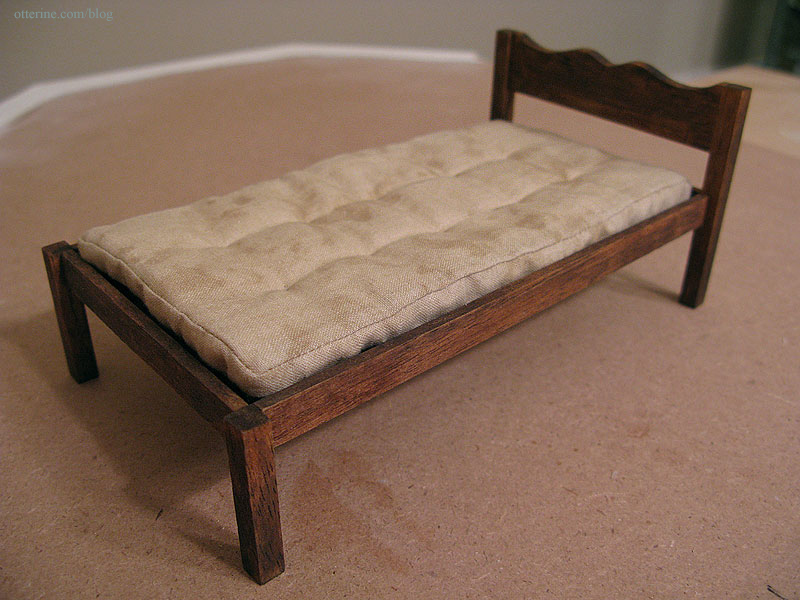
Categories: Baslow Ranch, Furniture
July 13, 2010 | 0 commentsWilliam Morris rug – part 1
I am stitching the William Morris rug shown on the front cover of the book Miniature Needlepoint Carpets by Janet Granger.

Her patterns are made for 18ct canvas, but this rug would measure about 9″ x 9″ using that material. Too large for my purposes, and 18ct isn’t as fine a finish as I prefer. I decided to stitch the pattern on 28ct fabric, which will result in a rug just under 6″ x 6″. I also decided to cross stitch this pattern to eliminate the tendency for the fabric to show through the usual needlepoint stitch.
I made a color copy of the pattern to attach to my magnetic board and liked the colors better than the original, so I visually matched the thread colors from my stash instead of using the suggested colors in the book. This is the rug after about 13 hours of work. Long way to go.

Now at roughly 33 hours of work. I’ll be finishing the second half of the design before filling in the background and border. I’m still undecided on those colors, though I have some ideas. I just love the design itself so much, I don’t want to detract from it.

At just under 70 hours, the entire design is done! :D

Now comes the long process of filling in the background colors. I am sold on the rusty red for the outer border but I am torn between the vanilla and silver-grey for the interior. My plan is to work on the red border for now and decide on the inner portion once that’s done.
I think the vanilla will be really rich looking – like red velvet cake with butter cream frosting. Yum! But, the silver-grey has its appeal as well – the peach and pink floral shapes will likely stand out more against the silver-grey.

Categories: Needlework - French knot rugs
July 10, 2010 | 0 commentsNewport – altering a prefabricated wall
The brick on the Newport is a finish the manufacturer completes before shipping the kit. If it’s marred, there isn’t a way to fix it. And, there’s no way to replicate it, either. The photo of the front porch below shows how the front of the house is recessed by the front porch window.

If built per the manufacturer instructions, the second floor would mimic this recessed pattern. Here’s the Real Good Toys photo showing the way the house is supposed to be put together.
Since I extended the front porch, put the addition on the “wrong” side — I planned it that way :] — and flipped the stairs, I needed to push the front wall on the second floor forward. This not only eliminated the huge flat roof on top of the porch but also gave me more room inside the structure. My problem is getting the front to look like one continuous wall on the outside.
The rub is that the walls are pre-cut with the brick finish. So, I couldn’t just glue the two pieces together since (1) the brick pattern wouldn’t match, (2) there was a gap between the two wall pieces since there was supposed to be room for the connectors that make the recess, and (3) the reason for the recess in the first place was to give the illusion of a tower running up the middle.
To fix the gap, I used a 3/8″ x 3/8″ strip of wood.

I glued each wall to the strip wood and let it dry.

To mask the strip wood and to follow the original vertical line of the mock tower, I cut a piece of 1/2″ x 1/16″ strip of wood and painted it white to match the other connectors. I glued it in place, lining it up with the connector on the first floor.

The strip wood connector won’t show on the inside once the wallpaper is in place. :] Problem solved!
Categories: The Newport
June 3, 2010 | 0 commentsBaslow Ranch – Attic
The attic was a lot of fun. I’ve seen other miniaturists’ attics with newspaper wallpaper, and I wanted to do something similar. I took images from newspapers online, resized and printed sheets on two shades of parchment paper I had in my stash from my old art school days. The subtle translucent quality and the mottled coloration added a lot of realism.

Then came the task of cutting out each individual page of newsprint so I could apply the paper piece by piece.
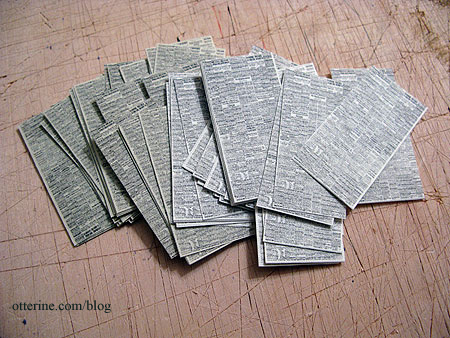
Once the attic floor was in place (in the photo below, you can see the pieces of strip wood I used to brace the divider), I glued beams along the walls, leaving 1 1/2″ between them. I then coated the wood beams with a black and brown wash.

I used the individual newspaper pieces to cover the sections between the beams, mashing the paper, gluing wrinkles in place and turning some corners down.

I love the way this turned out! :D

I used the same process on the ceiling portion of the attic and added some water spots with a brown paint wash.
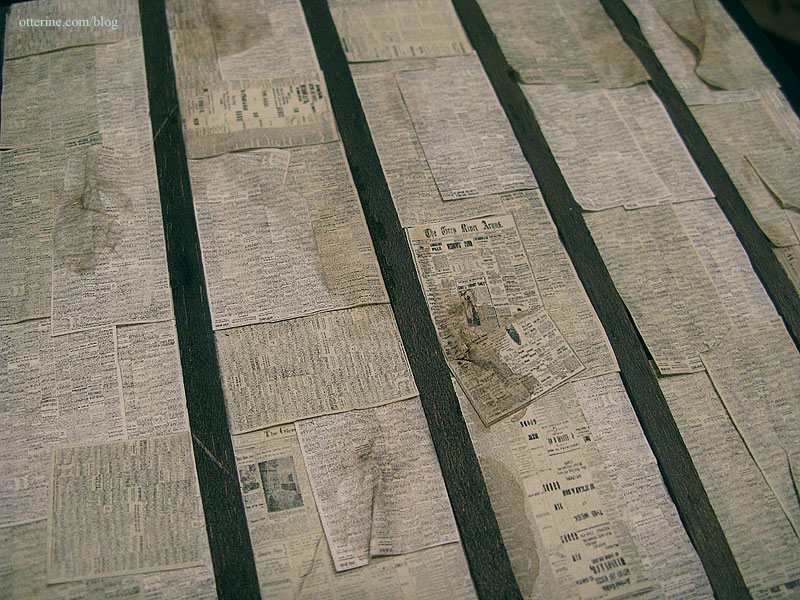
I had these books from a lot of furniture and accessories I bought from craigslist and covered them with covers I found on printmini.com, printed on parchment paper.

I placed one book in the room below and rest into a purchased crate that I aged with paint washes. The hurricane lamp is by Clare Bell Brass aged with brown paint. Its cord is hidden under the crate. This is a tiny room, but leaving it dark meant you couldn’t see the details I added.
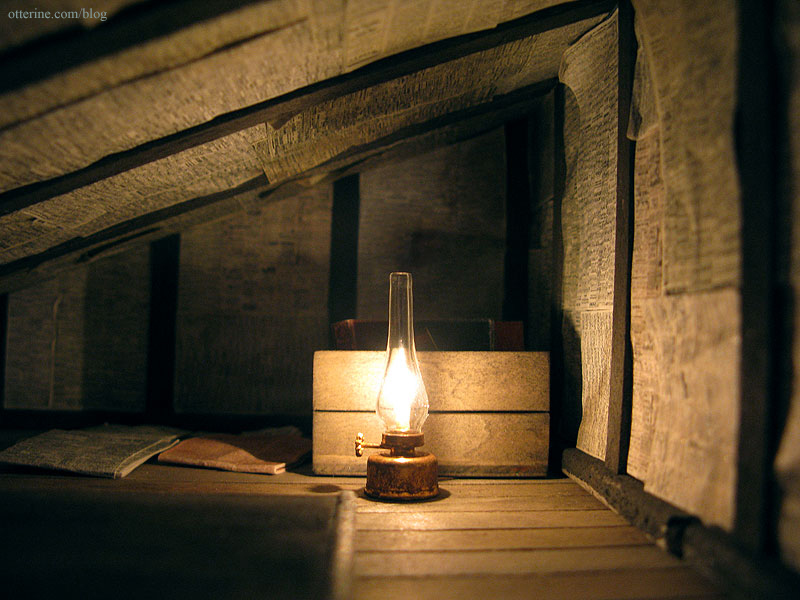
I love it!!!! :D And, the great thing about this room is that the older and dustier it gets over the years, the more realistic it will look.
Update from 2012: In addition to the light coating of dust from the past two years, the barn has apparently attracted the attention of small spiders — as barns are apt to do. There is a fine covering of webs inside the top of the barn by the lights.
Quite marvelous, don’t you think? :D It’s interesting to me since the lights aren’t often on and they wouldn’t really attract insects of any sort besides, but this is exactly where spiders would congregate in a real life barn — the perfect place to catch any insects attracted to the lights.
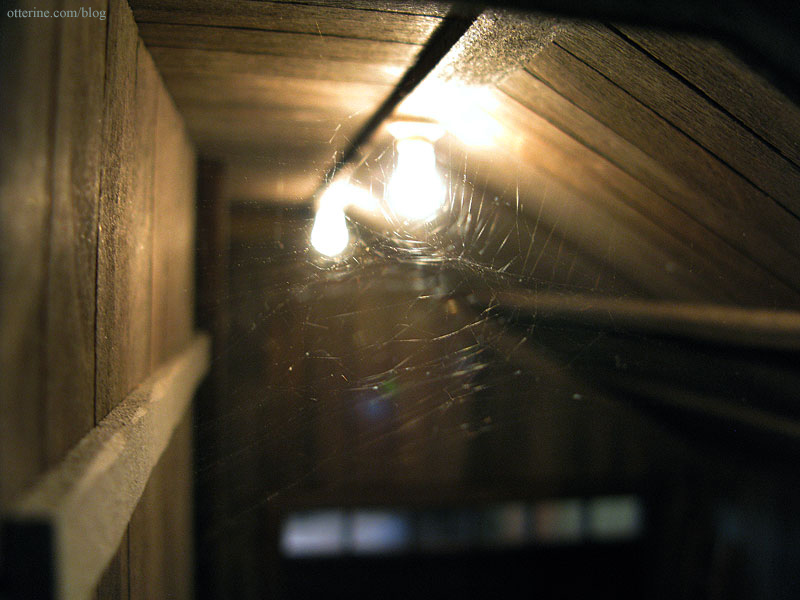
They aren’t shown in this photo, but the webs continue under the slight lip of the roof outside this wall, too. I suppose someday I’ll have to dust the house and remove the webs when they become overwhelming, but not yet.
Categories: Baslow Ranch
June 1, 2010 | 0 commentsBaslow Ranch – Room for Rent
The floor is made by scoring the kit’s floor piece to simulate planks. Using an X-Acto knife, I cut out pieces along some of the lines to create broken boards. I used a nail set to create the illusion of nails at the ends of the planks and then stained the wood with a paint wash.
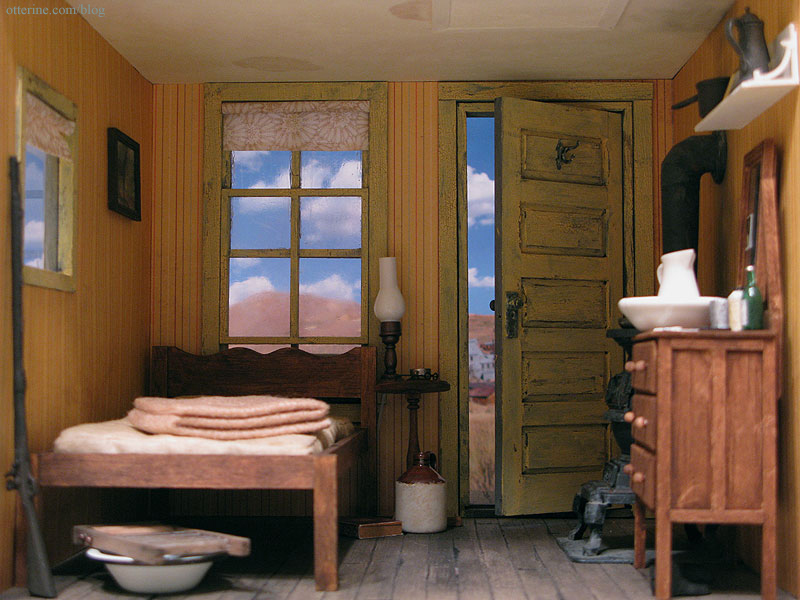
The wallpaper is scrapbook paper called Simple Stripes/Grandma’s Kitchen by We R Memory Keepers. It’s fantastic since it already has that worn and aged look printed in the design.

Using 1/8″ mdf, I added a ceiling to the side room to create an attic, access to which is simulated with a faux trap door (I used the tutorial on the Greenleaf site). The attic floor is covered with the same siding strips I used throughout, cut in half lengthwise, and then stained with a light wash.

On the underside, I primed the ceiling with white paint and then swirled on Vintage White paint by Folk Art. I used a brown paint wash to create water stains on the ceiling and trailed an X-Acto knife from the corners of the attic door to create cracks. I painted over the brass handle in the process. If you’ve ever seen an old house, you know painting over hardware was a common practice. :]
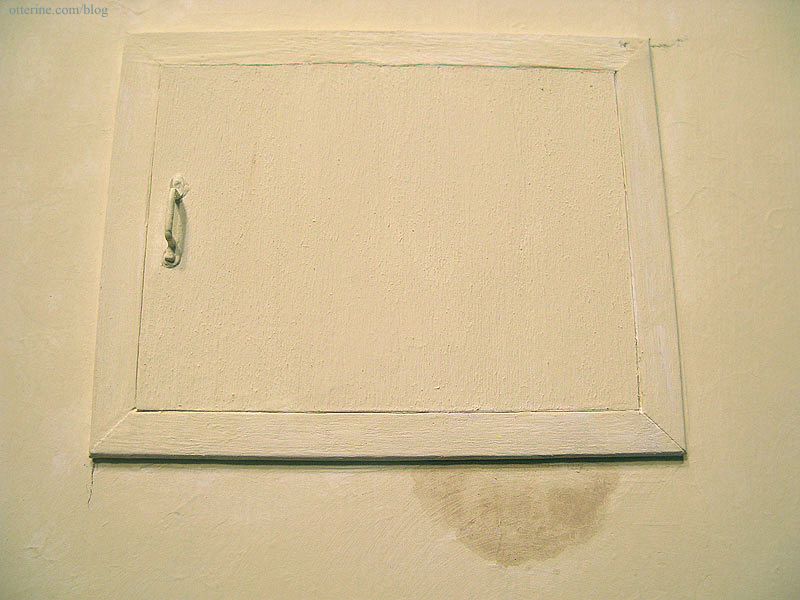
One happy accident happened as I was measuring for something. I had the ceiling taped in place at the time and accidentally made a long pencil mark on the freshly painted surface. Instead of trying to cover it with paint, which I didn’t think would work all that well, I used my X-Acto knife to lift the paint all along the pencil mark, creating a long crack in the ceiling.

I made the stove from a Chrysnbon plastic kit. I found this kit to be both realistic and very easy to assemble. Although the kit came in plastic molded in the proper color, I still sprayed all of the pieces with Testors flat black. I also sprayed the chrome pieces since I wanted this to look like an old stove without any fancy accents.

I added a red bulb to simulate warm coals.
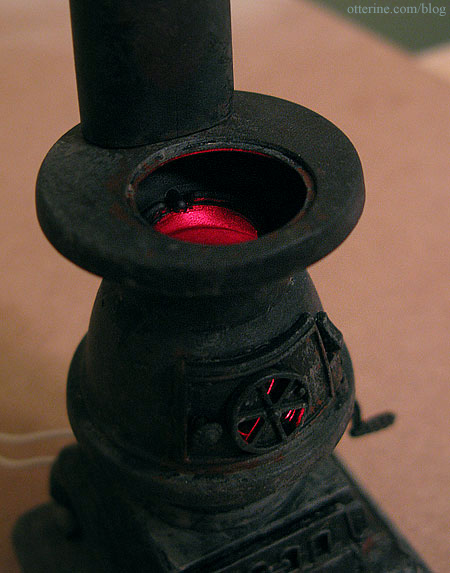
To achieve the aged look, I dabbed on Mushroom acrylic paint by Folk Art and a paint by Testors appropriately called Rust. :D
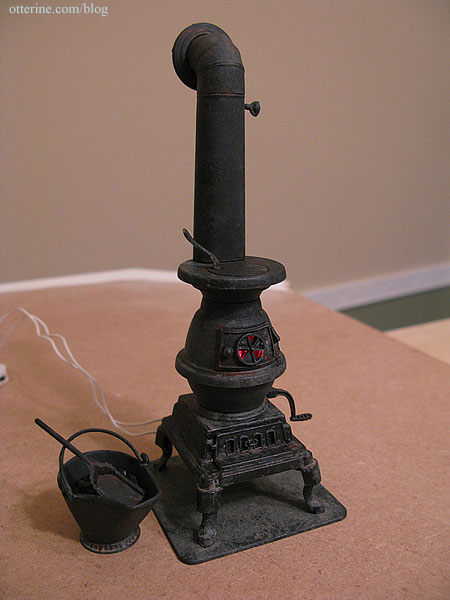
I painted the wires black and glued them to the inside of one of the back legs before feeding them through the floor. I used an X-Acto knife to shave dust from a black conte crayon and used a dry brush to dirty the wall and ceiling around the stove.
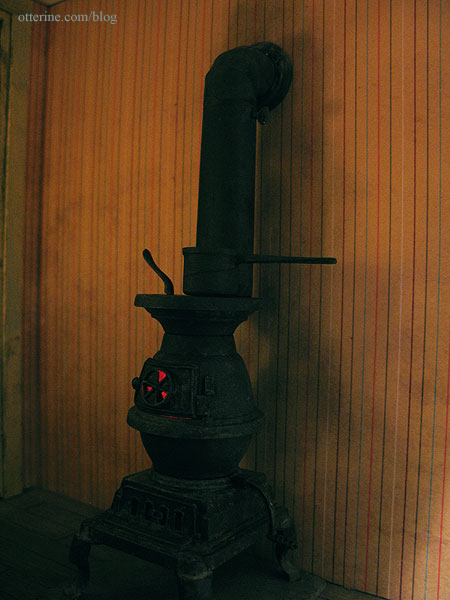
The windows, door and trims were first aged by beating, cutting and otherwise marring the finish and applying a wash of brown and black paint. I applied Crackle Medium by Folk Art and then painted Sunflower yellow by Folk Art.
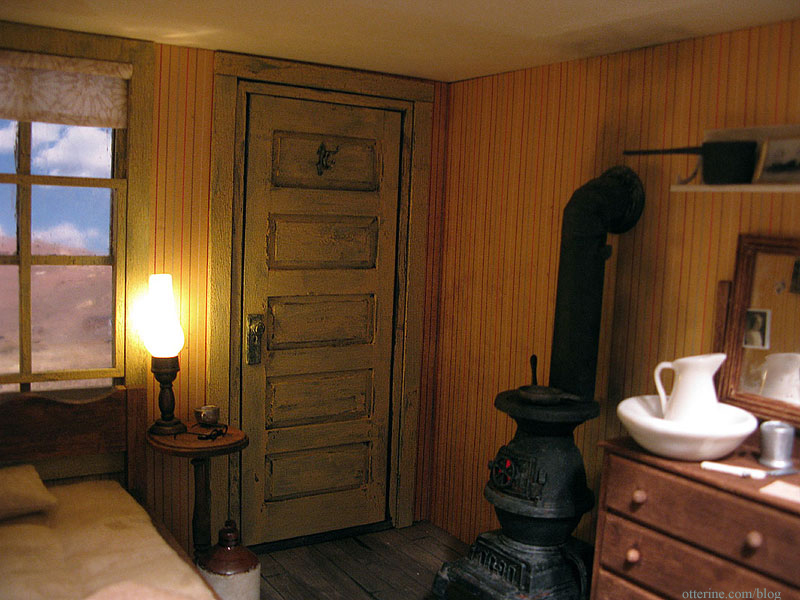
The lower interior window is removable so I can have the window partially open or closed completely. To age the glass (acrylic), I brushed on some Gloss Varnish by Delta Ceramcoat and then wiped away the excess. It took a few turns of this process to get a realistic look. The rolling shade is made from a scrap of fabric glued around a wooden dowel.
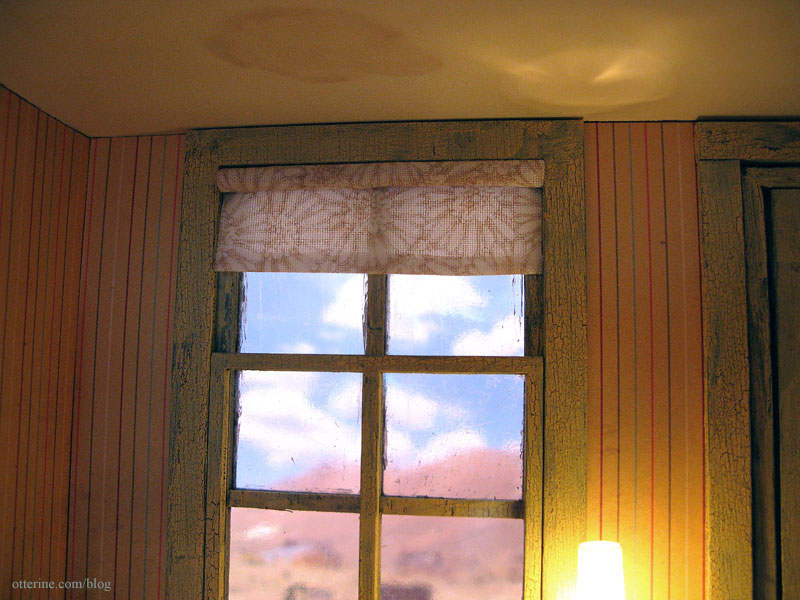
When the backdrop is in place, it really feels like you’re standing in a real life room. :D
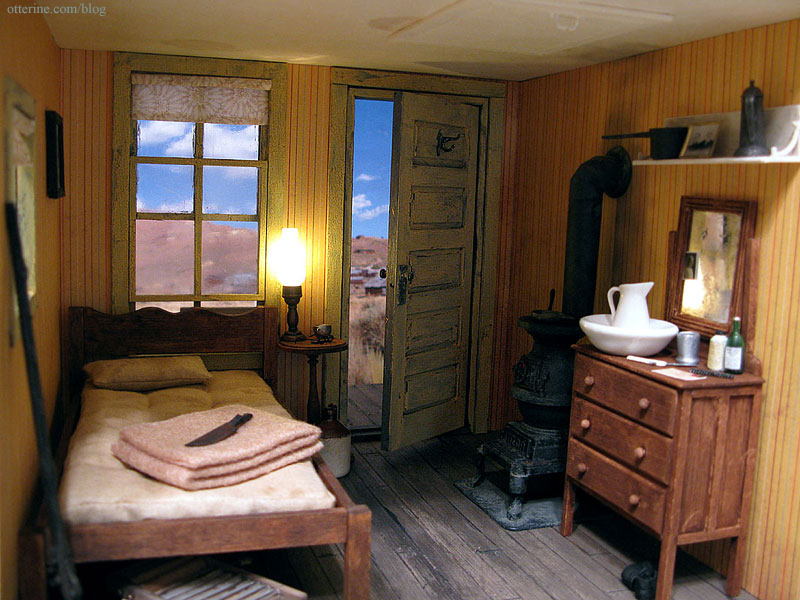
Categories: Baslow Ranch
June 1, 2010 | 0 comments
NOTE: All content on otterine.com is copyrighted and may not be reproduced in part or in whole. It takes a lot of time and effort to write and photograph for my blog. Please ask permission before reproducing any of my content. Please click for copyright notice and Pinterest use.







































